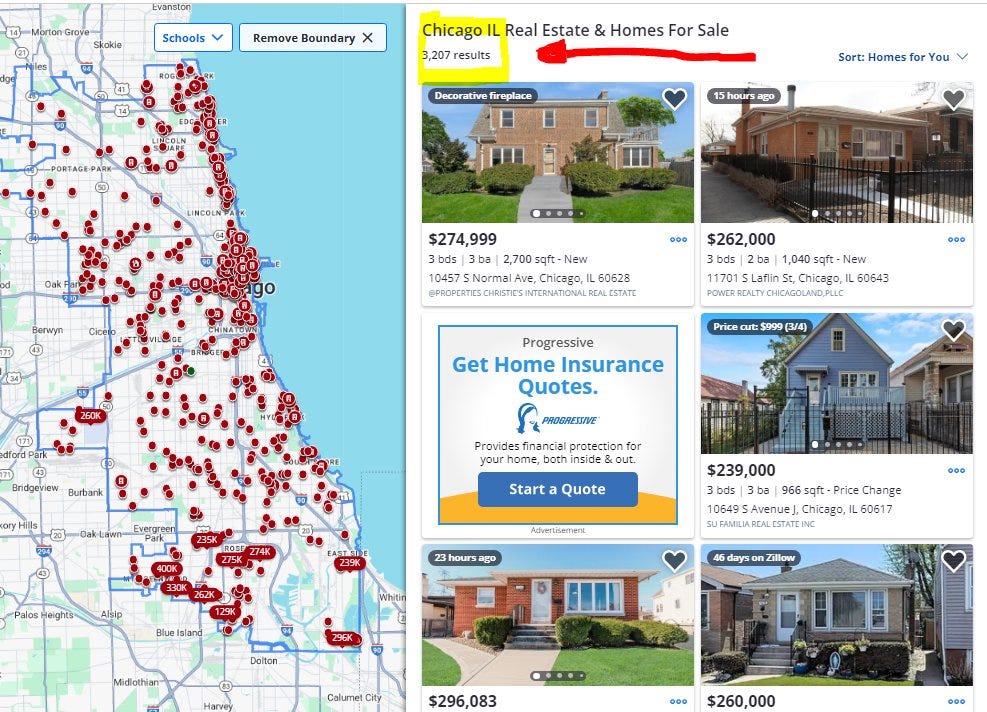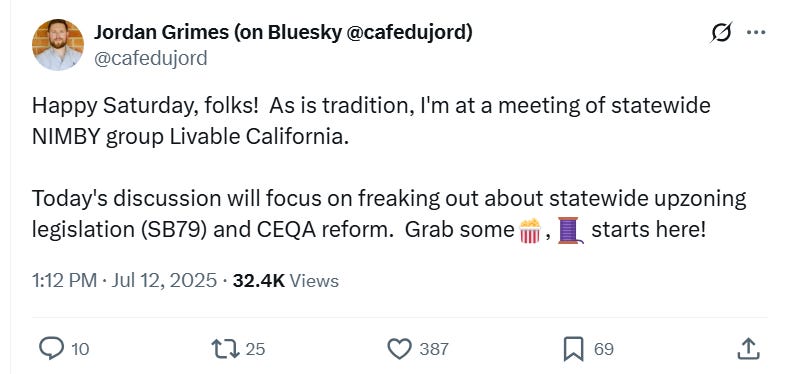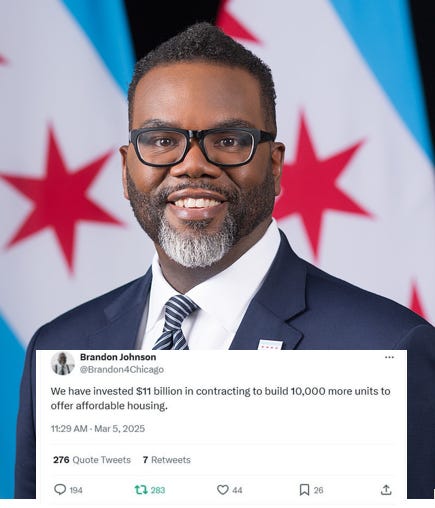$1.1m Per Affordable Home?
What the Chicago Mayor's tweet tells us About the failure of mass media on housing
Mayor Brandon Johnson's now-deleted tweet reveals more than just a math error. It exposes how politicized housing, uncritical media, and a broken discourse make it harder to build homes.
I was in Chicago last week, touring colleges with my daughter and reconnecting with old friends. Chicago rode the golden wave of American city building from 1870 to 1930, emerging as the world's tallest city. I consider it to be the purist laboratory for American urbanism.
It’s also a city of intensely politicized land use.
After the 1871 fire, Chicago was rebuilt into something astonishing. Its population exploded tenfold. It birthed the skyscraper. The Chicago School—with Louis Sullivan and his disciple Frank Lloyd Wright—defined The American Architecture. The downtown is so dense that 60-story buildings are irrelevant to the skyline. It’s a city of big ideas—and big contradictions.
Chicago’s 50 aldermen wield local veto power over development in their wards, a legacy of machine politics known as Aldermanic Privilege. It results in back-scratching, delays, and dysfunction. It also makes it difficult to have honest and professional conversations about housing.
This brings us to Chicago Mayor Brandon Johnson's viral tweet and what it reveals about the modern land use and media worlds.
Wait, How Many Homes? For How Much Money?
In March, Johnson posted that his administration had committed $11 billion to build 10,000 units of affordable housing.
The tweet didn’t live long.
Why? Because the math is as simple as it was damning:
$11,000,000,000 ÷ 10,000 units = $1.1 million per affordable home.
For my readers who might similarly struggle with the maths, this is a contradiction in terms. You can’t have affordable homes that cost 1.1 million dollars.
You can’t have affordable homes that cost 1.1 million dollars.
For context, in Durham, local builders deliver new housing for a tenth of that cost. I’ve seen the homes. I’ve developed the permit sets. These aren't luxury compounds. They’re modest, efficient, and well-designed. They are simple and affordable for one reason: they are depoliticized.
But the real scandal here is not that a politician flubbed a tweet. It’s that no paid journalist bothered to ask the most basic questions.
The Mass Media Vibe Machine
Consistently, journalists don’t check basic development math. Editors don’t assign follow-ups. The frame is already set: Government = Good. Business = Bad. If a nonprofit receives a $400,000/unit subsidy, it’s celebrated. If a private developer builds the same thing for $200,000, they’re attacked for being greedy.
Journalists and politicians co-produce these narratives. So when an elected official declares a massive housing investment, the default response is applause, never scrutiny.
And when projects are labeled Affordable they tend to float above criticism entirely.
In this politico-media environment, builders are portrayed as villains, even those delivering real affordability. Narrative wins. And facts don’t matter.
Citizen Journalists, Assemble
But on Twitter, the response to Mayor Johnson’s assertion was immediate and devastating.
People posted memes. The mayor was exposed as unprepared on the topic. And, after persistent ratioing (Twitter lingo for a tweet that generates more comments than likes), the tweet disappeared.
What happened?
Citizens did the division. Citizens checked the market. I personally documented 5,199 homes for sale in Chicago at the time of the tweet. Of those, 4,601 were under $1 million, and 3,207 were under $400,000. You could buy all of those affordable homes for about 1/10th the cost of Mayor Johnson’s program.

A politician made a huge, inaccurate claim, and the big boys of media were nowhere to be found. Who stepped up? It was people with free social media accounts, no bylines, and some basic calculator and Zillow skills. It was not the recently acquired-for-$630,000,000 Chicago Tribune that held Johnson accountable. It was Twitter.
This is, frankly, weird. But the story is not new.
This Is How the YIMBY Movement Was Born
In San Francisco—the belly of the beast for progressive NIMBYism—wealthy, overhoused residents have dominated local land use politics for 50+ years. They weaponize ostensibly neutral and professional institutions, such as planning commissions and neighborhood associations, specifically to prevent development.
For years, nobody noticed. Newspapers didn’t cover it.

Then, a new generation of younger, left-leaning activists began to attend these meetings. They brought their camera phones. Leaders like Jordan Grimes tweeted transcripts. They demonstrated how meeting leaders were bending (sometimes breaking) rules to protect their views, their parking, and their appreciation rates.
When the San Francisco Chronicle wasn’t in the room, YIMBY Twitter was.
A Broken Discourse on Housing
What’s happening in Chicago now is just the latest chapter in a larger breakdown in national housing discourse. Here are the uncomfortable truths:
America politicizes housing, then excludes anyone who understands housing from politics.
Politicians and traditional media vilify businesspeople, especially builders, then demand they solve the housing crisis unilaterally.
This system perpetuates a media culture that rewards vibes, ignores math, resists reform, and creates civic environments where it is challenging to build anything.
The result is that the people managing housing policy generally don’t know much about housing, like Mayor Johnson. And the professional journalists covering those policymakers don’t know much about housing, either. So the conversations get dumber and dumber each year.
That’s where traditional media is in 2025.
It’s ironic that the only critical discourse on housing is happening in a deeply dystopian digital space, sandwiched between AI bots and conspiracy theorists.
Weird times, indeed.





"Chicago’s 50 aldermen wield local veto power over development in their wards, a legacy of machine politics known as Aldermanic Privilege. It results in back-scratching, delays, and dysfunction. It also makes it difficult to have honest and professional conversations about housing." It is a two edged sword. If you are trying to do something that the alderman believes that their community doesn't want, which he is therefore opposing (which is in itself a problem, since the "opinion" of a community can be difficult to really determine, but reelection depends on a majority of the residents in the community supporting the alderman), it is very difficult to get through the approval process. However, if the alderman supports the project, approvals are expedited and needed support forthcoming. Chicago is still the city of the first Mayor Daley, whose method was a trade of this for that. While that was rumored to have sometimes been inappropriate pay offs, it was also the way that the city could get something that it needed in exchange for giving the developer something that they needed. We needed a variance to add a fourth floor on one of our buildings in Wicker Park. We sought the alderman's support. He pointed out that we had some extra space on the alley behind our building. He also pointed out that many of the other buildings on that block had buildings that did not have extra space sufficient on the alley to accommodate a garbage storage area. We agreed to allow the city to position a large garbage dumpster on our extra space to accommodate the other properties on our end of the block. This didn't cost us anything and solved a neighborhood problem. In exchange, the alderman supported our request and the variance was granted.
Looking into it, I think the mayor dropped a zero. There is info noting a commitment of the city to create 200,000 housing units over the next 10 years. There is also a recent announcement from the Governor to provide $27.8 billion to create 327,000 affordable housing units in the State, which includes the acquisition of existing compromised buildings for restoration, as well as new units. That pencils out to $85,015 per housing unit. My guess is the Mayor's round numbers should have been 100,000 units for $11billion.